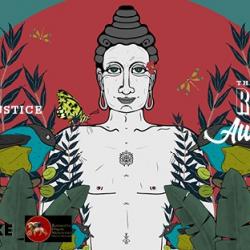Remember this word: Pareidolia.
We’ll come back to that in a moment.
Sarcasm in print is always tricky. In pithy stories reporting science news, all the more so. Thus a well-earned tip of the hat is owed to the folks over at Discovery News for their coverage of the alleged Buddha statue showing up in one of last week’s Mars Curiosity Rover photographs. Pointing to two real space science stories, they conclude:
Sure, they told us about liquid water on Mars today and the odd glint from a star 1,480 light-years away that could, just maybe, suggest alien megastructures. But this news about a Martian God statue on the Red Planet certainly tops the list of exciting space news this week.
The image in question is this, taken from NASA. If we zoom in a bit, something begins to take shape:
This is apparently what we’re looking at:
And, zoomed in a bit more:
Sure, a little imagination, a suspension of any type of critical thinking, and bam, you’ve got a figure of some kind.
The website UFO Sightings Daily writes:
This is a better view of it and shows a face and head turned to its right, with breasts and a plump stomach, shoulders. Very remarkable detail in this photo. This photo alone should be enough to convince the United Nations that intelligent life once existed on Mars, but NASA doesn’t want anyone to know the truth, because they will be asked to share the info and technology that they have found.
Better than that, we even have someone who has gone a step further, editing the image to make it clearly look like a “Stunning Martian God”:
This led me to wonder: how and when did the “Martian God” of youtube lore (Oct 9) become the “Buddha statue” of Discover News (Oct 18)? And why?
As far as I could tell, we owe the creative shift to stories on Oct 14 in two UK-based Tabloids: The Mirror and The Metro. Both articles are also short and tongue-in-cheek about the whole thing, but add -for no clear reason- that it’s a Buddha statue. It spread slowly from there, in the Sun on the 15th, Daily Mail on the 16th, and finally hopping over the pond to the HuffPost on the 17th. It also spread to the continent and to India in that time and no doubt we’ll see the story “make the rounds” for a while longer.
But the take-away from this, beside the fact that there is no Buddha statue on Mars, is that some people seem to be convinced by these strange theories and yet others feel compelled to drum them up. That brings us back to our word of the day: Pareidolia. As reported in the Daily Mail story (with some editing and links added):
Many scientists believe that seeing strange objects, such as a ‘coffin’ on Mars, is simply a case of pareidolia.
This is a psychological response to seeing faces and other significant and everyday items in random places.
It is a form of apophenia, which is when people see patterns or connections in unconnected data.
There have been multiple occasions when people have claimed to see religious images and themes in unexpected places, especially the faces of religious figures.
Many involve images of Jesus, the Virgin Mary and the word Allah.
For example, in September 2007 a callus on a tree resembled a monkey, leading believers in Singapore to pay homage to the Monkey god.
Another famous instance was when Mary’s face was a grilled cheese sandwich. Images of Jesus have even been spotted inside the lid of a jar of Marmite and in a potato.
As it turns out, I wrote about the same phenomenon about two years ago when the face of Jesus appeared in, well, an unexpected place (hint: the less attractive end of a pug). I wrote then:
The simple, natural explanation, is that we see things that we want to see, sometimes when they aren’t really there.
The flip-side of this is that we just as often see things we’re afraid of even though they aren’t there. That is where the Buddhist story of the snake and the rope comes in. As far as I can tell, the story isn’t found in the early Pali sources. The story, as I was first told it, goes something like this: A man, filled with a mind of fear, walks in to a shed and sees a snake coiled in the corner. Fearful, he runs away. Later, with a mind cooled of fears, he returns to the shed. There he sees that the snake is just a rope, coiled up in the corner. A recent Tibetan master elaborates thus:
“Sentient beings, self and others, enemies and dear ones—all are made by thoughts. It is like seeing a rope and mistaking it for a snake. When we think that the rope is a snake, we are scared, but once we see that we are looking at a rope, our fear dissipates. We have been deluded by our thoughts. Likewise, mentally fabricating self and others, we generate attachment and aversion.”
In science, this is called confirmation bias: the process of actively searching out or interpreting evidence to support your own preconceptions. In Buddhism it is simply our ignorance, perpetuated by saṅkhāra/saṃskāra (mental formations). One of the powerful effects of meditation – for most of us – is the ability to see our own mental formations. If we are angry people, we ‘see’ images, thoughts, and feelings of anger arising in our mind. [read more]
Discovery News has a list of its Top 10 weirdest Mars Illusions and Pareidolia and
Live Science posted Mars Hoaxes! 6 Stubborn Red Planet Conspiracy Theories in August (the Buddha statue may be a good #7)…















